It is hardly possible country cottage area or imagine a house without a well thought out sewer system. In order to achieve the correct effective work systems, you need to build a special septic tank from concrete rings. There are no difficulties in erection, so you can make everything with your own hands without resorting to the help of specialists.
A septic tank is a design that provides purification and clarification of waste water. Previously, for such processes, it was built cesspool, but the service life and feature of the septic tank are much superior to the old options. The most common, although not the only materials are concrete rings. Waterproofing a septic tank is carried out using various materials.
Features of a concrete septic tank
The installation scheme is such that the rings are placed one on top of the other, which means that the resistance to the movement of groundwater or the soil itself remains minimal. You can use a monolithic septic tank, or connect the rings with ties (metal rings). The main disadvantage of a septic tank is the inevitable ingress of a small amount of waste into the ground. Leakage occurs because it is not possible to perfectly seal the circumferential joints.
The building elements are quite heavy, so inserting the elements with a crane will greatly facilitate the work, although their cost will increase.
Main scheme
The scheme of the septic tank from the rings is a certain number of wells connected to each other. The meaning of each of them:
- the first of the sections is a well with a concrete bottom. It should be connected to a pipe that removes all waste. The insertion of the pipe is carried out with a slight slope so that the waste is removed independently. The angle of the installed outlet is normal if there is 2 cm of slope for each meter of length.
The section serves to allow solidified waste to decompose well. The action is carried out because the waste contains anaerobic bacteria that can quickly decompose all masses. When a thick sediment occurs, liquid fractions begin to flow into the second tank section; - the second tank is made the same size as the first. Their devices are identical. This compartment is used for filtration. Here are the materials that are responsible for its natural course (not a large number of gravel, expanded clay and similar substances);
- the next tank contains the filtered fraction. The received liquids from this compartment can be discharged into the ground in a natural way, or, for a more thorough removal, use forced removal using a pump. When removing liquids with a cesspool machine, the location of the third tank should be carried out in close proximity to the access routes.
Rubble pad
The main problem when installing septic tanks is soil heaving, that is, an increase in the size of the soil under the influence of various external factors. When installing a septic tank in places where the soil is very heaving, you need to build a belt of soil. Experts give recommendations on the choice of materials. The best for bedding is an expanded clay pillow, or materials with a similar composition.
The material is not so important, the main thing is to make a pillow before installing concrete rings. The pillow should be at least 30 cm thick. The rings should be fastened with metal bolts or staples. Seals are inserted so that due to heaving there are no shifts of the rings, and sealed places do not let the contents into the ground. A hatch should be made in each section so that access to the contents is easy.
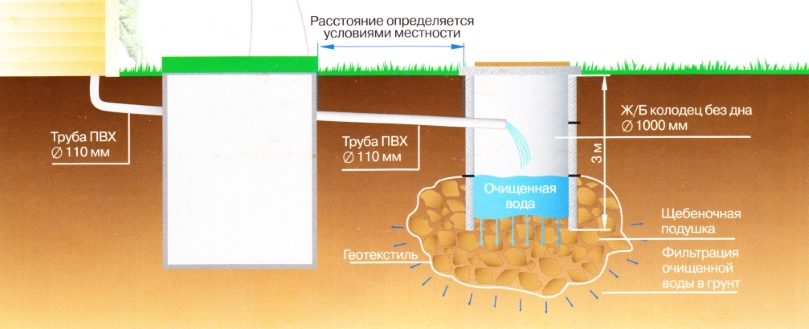 Photo: crushed stone pillow should be poured only if there is no bottom in the well
Photo: crushed stone pillow should be poured only if there is no bottom in the well Seam waterproofing
An important factor in carrying out the work is the insert insulating materials both inside and outside. Waterproofing is often insufficient because faecal water is not completely isolated. So special isolation is done with compounds that are designed for this. All surfaces should be insulated, because even such durable materials will be destroyed by waste. The process is called "concrete corrosion". If such processes begin, the septic tank will significantly reduce its service life.
 Photo: using bitumen in conjunction with a clay castle
Photo: using bitumen in conjunction with a clay castle Penetrating waterproofing
The waterproofing of the septic tank will be made as reliably as possible when using penetrating waterproofing. When processing the ring on both sides, the concrete is better protected, since the composition penetrates the entire thickness of the wall. There are now a great many mixtures for insulating the surface, for example, Penetron. Produced specifically for this type of work.
Even with good seam processing, the rings should be fixed as high as possible so that there is no displacement. The seams are being processed. Work is done when the rings are installed. You can use gaskets, but the elements are inserted into the cement mortar. Further, the manufacturer's instructions will tell you how to properly apply the composition to the surface, so you should use it.
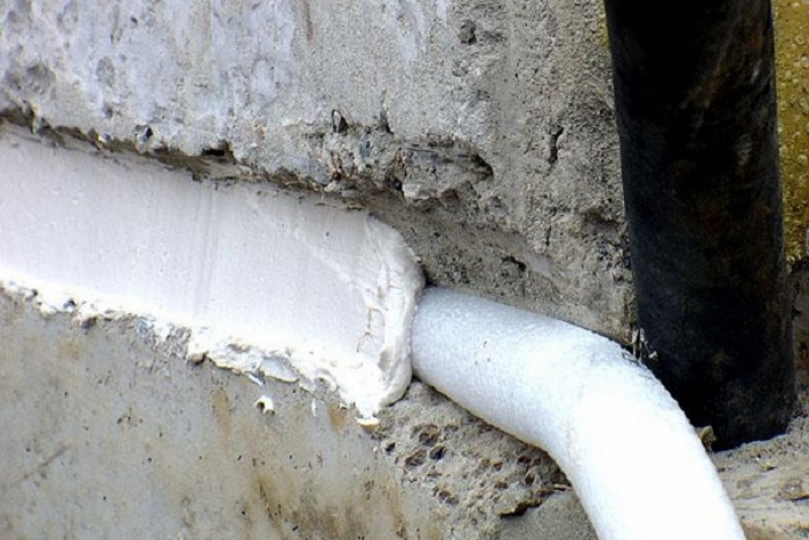 Photo: sealing seams with sealant
Photo: sealing seams with sealant bitumen insulation
The waterproofing of a septic tank made of concrete rings is carried out using bitumen, which, when hot, is an excellent insulation. The service life of the material is not very high, so it will soon begin to crack or flake, and it does not tolerate frost and thaw. Better enjoy bituminous mastics, which incorporate many additives to improve properties. Serve such materials will be much longer. The mask should be applied cold. Such work does not cause difficulties, it is important to perform without skipping sections.
Polymer cement insulation
You can replace other types of insulation with cheaper ones. The main thing is that all places are airtight. One of these cheap types is polymer cement or coating cement. Such material will serve for a long time, compared with bitumen. It is easy to apply with a brush in two layers. The second layer must be applied immediately after the first, as soon as the fixing has begun. The "wet on wet" principle. Seam joints are treated with sealants.
clay castles
For insulation from the outside, you can use a clay castle. With this method, the well is filled with a pure clay composition, sand is not added. Then everything is rammed. It turns out that the access of groundwater to the bottom of the well is blocked. But using only this method will not be enough, it is better to use it in conjunction with others. The thickness of the clay layer should not be lower than 25 cm.
plastic pipes
Alternatively, you can take rare measures - use plastic rings for a septic tank. You can use barrels or plastic pipes for such purposes. Only there is little sense in such isolation, because it is easier to construct wells with these materials at once. The insulation will be strong, the most durable.
Conclusion
Whatever method of insulation of concrete structures is chosen, it is important to select it taking into account the environment, the purpose of the tanks. The work is carried out only with the highest quality, since if the performance is unsatisfactory, it will soon be necessary to do everything again.
A concrete septic tank is one of the most common sewer structures at present. In order for it to function effectively and for a long time, and also not contribute to the occurrence of serious problems associated with the penetration of sewage into the ground or groundwater into the sewer, it is necessary to correctly and timely carry out waterproofing and septic tank sealing.
Septic tank waterproofing made of concrete lies in the fact that through the use of special insulating materials, the structure is protected from the penetration of groundwater and the harmful effects of aggressive wastewater contained in chemical substances(acids, alkalis, etc.) on the material from which the structure is made.
The purpose of sealing a septic tank is to prevent sewage from entering the ground water. Sealing is carried out by using special materials - sealants. They are designed to provide complete sealing of the structure. Usually for sealing concrete septic tank use a material such as silicone, which has sufficient density and is able to completely close the existing holes.
How to waterproof a concrete septic tank?
In the case of low groundwater and due to poor waterproofing, it may happen that wastewater will seep through the existing cracks directly into the ground. And this can cause various problems, since such waters contain a large number of microorganisms, many of which are harmful to the environment. In the case when groundwater is located high, they will become infected with microorganisms that are in wastewater instantly. To carry out the complete sealing of a concrete septic tank, a special plastic insert in the form of a cylinder is used, which is inserted into the concrete ring. By means of a jigsaw or a crown in the body of this cylinder, an entrance and an exit are cut at the required height, and then it is sealed with silicone. If the groundwater is high, then the cylinder should be reinforced with ring stiffeners. In that case, the water from it should not be pumped out completely.
The above cylinders are made of polyethylene, the wall thickness is eight millimeters. The cylinder is sealed. Diameter 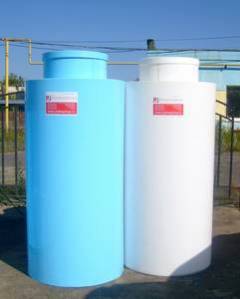 it can be 900, 1400 and 1900 mm. As for the height of the insert, it ranges from one to four and a half meters.
it can be 900, 1400 and 1900 mm. As for the height of the insert, it ranges from one to four and a half meters.
It should be noted that the waterproofing may begin to break down after the winter period ends. Due to the seasonal displacement of the soil, as well as its partial freezing, some displacement of the concrete rings is possible. This may contribute to the violation of waterproofing.
When installing a septic tank made of concrete, it is necessary to take into account at what distance from the dwelling it will be located. This is determined by sanitary and building codes, and so that when cleaning the septic tank, an unpleasant odor does not penetrate into the house.
A concrete septic tank is just one of many types of septic tanks. Its main advantage over other septic tanks is that its installation is very simple. In order to meet the needs of a family of four, it will be enough to install one concrete septic tank of three rings. To place the septic tank rings in a specially equipped pit, only one lifting device or a crane.
The disadvantages of a concrete septic tank include the fact that concrete can absorb moisture. This can lead to the fact that groundwater, when freezing, will simply squeeze it out of the ground. So you need to place a septic tank made of concrete so that it is as far as possible from groundwater. In addition, on concrete
In any water supply and drainage system, it is extremely important to ensure a competent waterproofing of the structure, so that leakage is prevented and groundwater enters the tanks. This issue is also relevant in the protection of special structures - wells made on the basis of concrete rings, since they are often used as containers for drinking water or autonomous sewage.
Wells built using prefabricated components, it is advisable to build to make a reservoir for storing technical, drinking water or organizing a sewer system. The first two options given are especially demanding to prevent leakage of underground sources inward, since this can adversely affect water quality.
Note that improper arrangement and processing of such a system can lead to a deterioration in the condition of the soil and groundwater where the corresponding reservoir is located. For this reason, waterproofing sewer wells made on the basis of concrete rings, is carried out already at the stage of construction of the structure.
Septic tanks
Sewer wells need a mandatory waterproofing device that provides reliable protection environment from the ingress of impurities. Note that they can have not only a huge amount of organic matter, but also many pathogens. Of course, contaminated soil can adversely affect plants and human health.
drinking wells
Drinking wells tend to be isolated from the penetration of ground surface water into them. This is explained by the fact that they contain all kinds of bacteria and large suspensions. The ingress of even a small part of such a solution into the tank can cause significant damage to the human body.
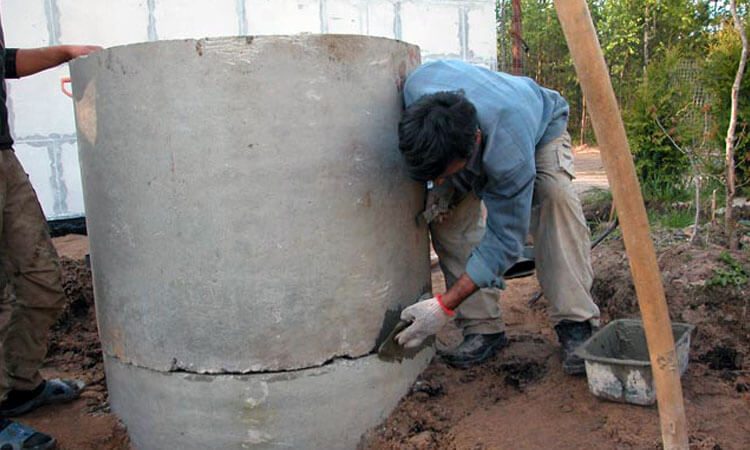
Figure #1. Seam waterproofing
When to update waterproofing
Concrete rings from the outside and from the inside are usually processed even at the initial stage of building a well, since the material from which they are made easily absorbs moisture. During the operation of the structure, restoration may be required. protective coating, indirect signs which may be the following factors:
- - the appearance of displacement of the rings relative to each other;
- - too fast and excessive filling of the sewer system;
- - mechanical and chemical destruction of the components of the well, with the formation of cracks, which will inevitably cause leakage of the contents;
- - determination of foci of corrosion of reinforcing elements, which leads to the infiltration of ground moisture through the waterproofing of the septic tank.
In each case, it is necessary to immediately restore the protective coating and seal the joints. Lack of proper attention can lead to bad smell, in the case of sewerage, or the deterioration of the quality of drinking water in the corresponding wells.
Reliable arrangement of concrete elements, taking into account the impact on them of aggressive environments and substances, is feasible only with waterproofing of the septic tank.
Video #1. Well waterproofing
Plaster protection
Often in the construction of tanks, finishing is used on the outside and inside with a special component, cement, which has a low% shrinkage and water permeability. It is applied to the surface by means of compressed air, under significant pressure. The result is a compacted and even layer over the entire working area of \u200b\u200bthe structure.
Processing is carried out using a "cement gun". It is recommended to lay the mortar in two layers, while the thickness of each should be within the range of 5..10mm, with minimum temperature air is not less than +5 degrees. The next layers are applied when the previous one is completely dry, which may take a total of about 10 days.
Due to high evaporation, in hot weather, the applied coating must be watered after 4..5 hours. In moderate conditions, the specified interval can be increased by 2-3 times.
Bituminous waterproofing
The simplest and most reliable method of sealing is the use of hot bitumen. The material is an excellent insulator, but it does not tolerate temperature extremes and is prone to delamination over time. In view of this, mastics and additional components are added to the bituminous mixture.
Before starting work, you will need to thoroughly clean the exterior and internal parts each ring. Then the application of the first bituminous layer, prepared using gasoline in a ratio of 1 to 3, is ensured. Further application of the material is provided with a solution in a ratio of 1 to 1. It is desirable to withstand all layers until final drying. Each subsequent layer based on hot bitumen is distributed with a roller or brush.

Figure #2. Bituminous waterproofing of concrete rings
On top of the frozen bitumen, mastic is laid in a layer within 2..3 mm. On the outside of the concrete rings, on top of the mastic, a roofing material or any other insulating element is fixed.
Dignity bituminous waterproofing a septic tank is considered to be the ease of implementation of work and their relative accessibility. At the same time, it is impossible to obtain a 100% guarantee of protection here; moreover, the method is not recommended for drinking tanks.
Penetrating protection
Penetrating waterproofing has proven to be quite reliable, proven and effective way protection of concrete rings. Excellent parameters are shown by innovative and progressive compositions, including Penetron, Lakhta, Hydro S and others, capable of maintaining their characteristics throughout the entire period of operation of the wells.
Each of these components is able to easily penetrate into the pores of concrete, fill all the cavities and crystallize in them. The resulting structure retains its breathable base, while acquiring unique waterproofing qualities. As a result of processing the base of each ring, inside and out, a surface with a uniform and hermetic composition is provided. This allows it to withstand for a long time high pressure and the pressure of aggressive environments.
Depending on the temperature conditions, humidity, porosity and density of the material, the crystallization time of the composition, as well as the depth of its penetration, may vary. Note that an increase in moisture affects the acceleration of the process of creating crystals. This behavior of the material allows concrete rings to impart a special “self-healing” property.
It should be understood that the penetrating waterproofing of a septic tank is performed exclusively on a properly prepared surface. For this purpose, concrete is ground mechanically or chemically until a uniform, rough surface appears.
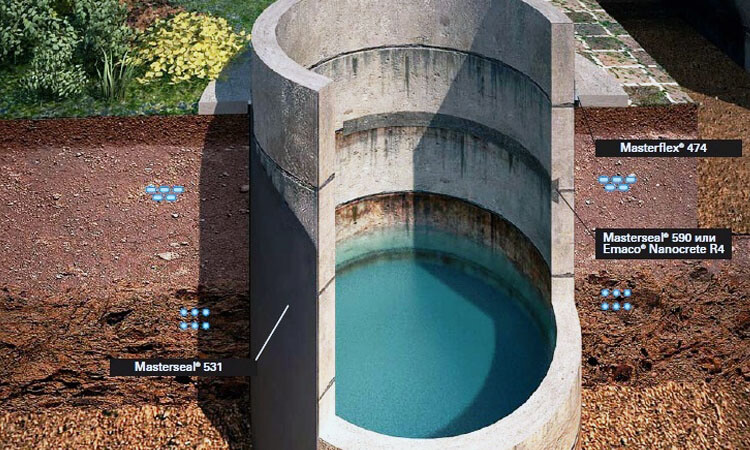
Figure #3. Well waterproofing
Polymer-cement protection
The most advantageous in terms of accessibility and easy to apply is polymer cement or coating waterproofing. It is carried out by distributing a special mixture made on the basis of cement, liquid glass and polymers. This protection has the same effectiveness as bituminous, while it can last a much longer period.
Conclusion
As you can see, waterproofing septic tanks and wells based on concrete rings is not easy, but it is impossible to do without it. It is important to responsibly and carefully consider this issue. In the absence of the necessary skills and knowledge on the choice of waterproofing, it is advisable to entrust this matter to professionals.
One of the indispensable conditions for achieving comfortable living in a country house or in country house- this is the presence of all plumbing fixtures and their normal functioning, which cannot be achieved without good sewage. Immediately comes the idea of installing a septic tank from reinforced concrete rings on the territory of his estate. It is not at all difficult to carry out such a construction at home. To do this, you need to dig a hole with an excavator or manually, and install reinforced concrete rings using a truck crane (or manually).
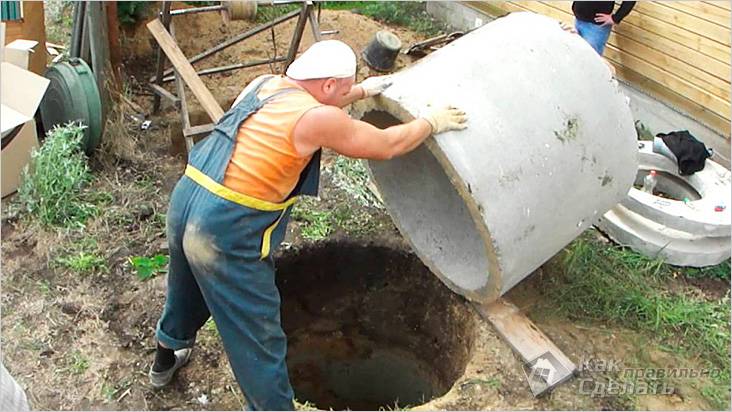
After completing the installation work, it is necessary to seal the septic tank for its correct operation. In this article, let's look at all the details of sealing work. Using these recommendations will not great work do the work on your own.
Purpose of sealing
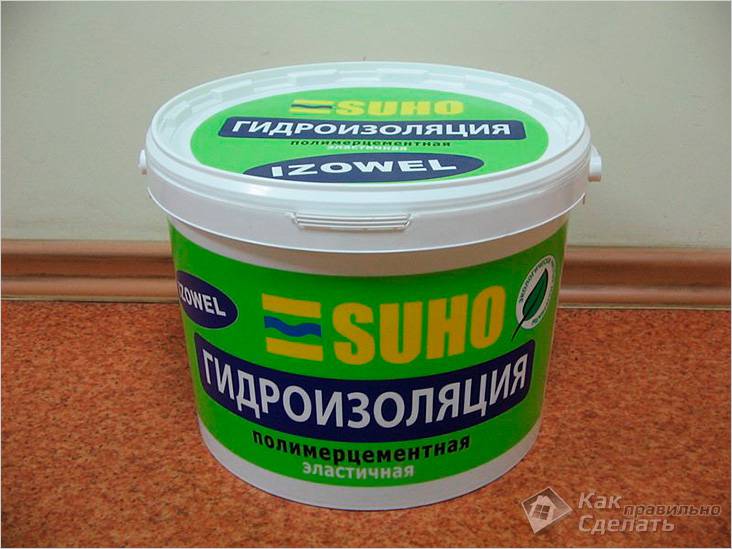
Currently, the use of a septic tank made of concrete rings is popular among owners. summer cottages and private houses. But it is no secret that for the septic tank to work properly, it is necessary to waterproof it - this will make it airtight. This work must be done without fail. If you neglect these rules, then the septic tank can become a source of infection on personal plot. Sewage will seep through the leaky walls of the septic tank, thereby contaminating groundwater. And the ingress of groundwater itself into the septic tank will overflow it and lead to improper operation. That is why sealing a concrete septic tank is so necessary and represents the protection of the entire concrete structure.
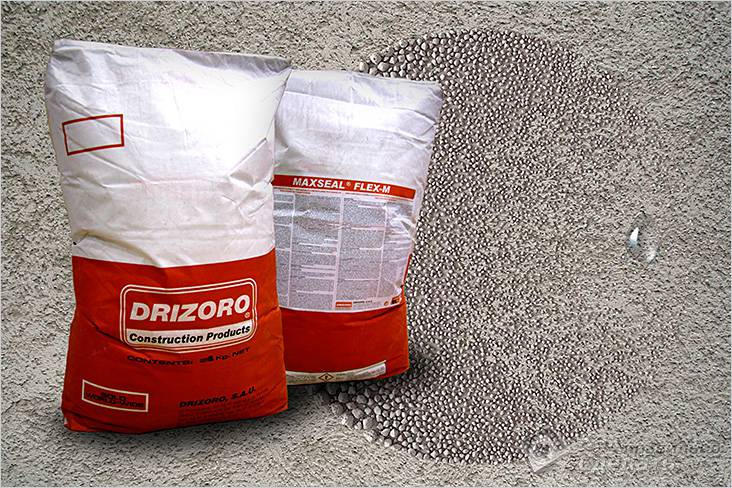
For sealing, it is mainly used:
- bituminous waterproofing;
- penetrating waterproofing;
- polymer cement waterproofing;
- plastic inserts;
- silicone.
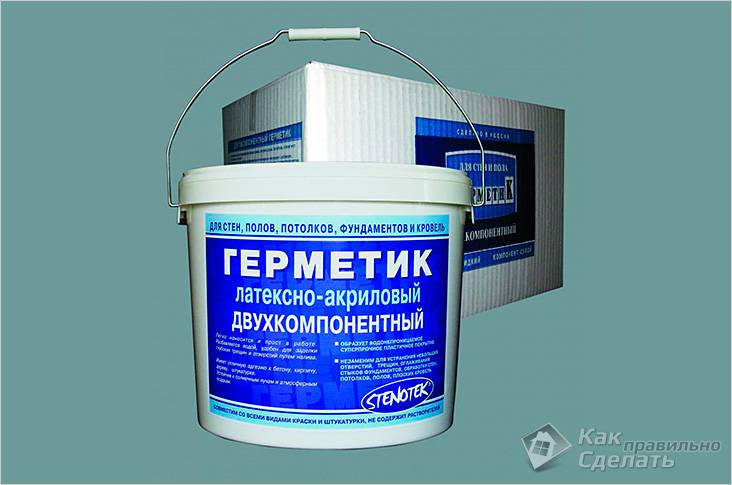
According to its structure, silicone has a high degree of density. Processing the entire surface of concrete rings, silicone gets into all holes and crevices. Thus, preventing both the ingress of groundwater into the septic tank and the exit of sewage into the ground. Of course, other sealants are also used, but silicone has the highest degree of protection.
Sealing process
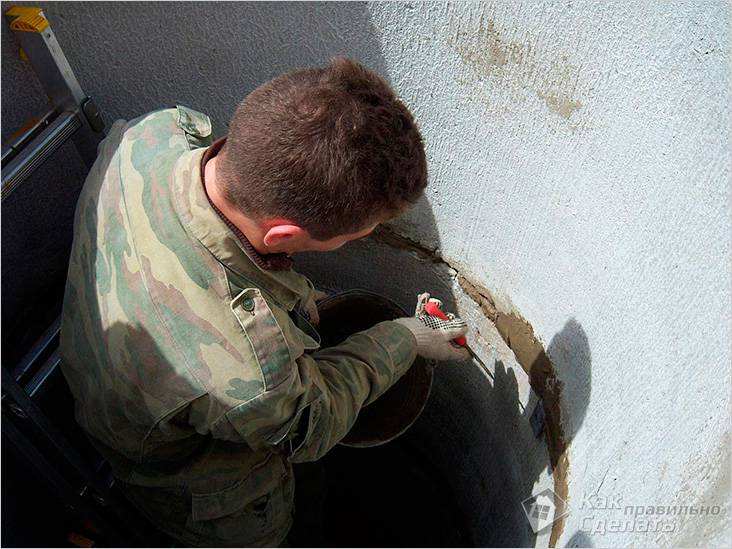
So, you installed concrete rings into the dug hole with the help of a truck crane. If the edge of the ring has a special lock for mounting, then its connection will be tight. Rings with a flat edge do not have a good density, so the joints must be sealed with a cement-based sealant.
Special tightness must be bottom ring with the bottom of the pit. When the ring design has a poured bottom, there is no question of additional sealing. But if you installed a simple ring, then the bottom of the pit must be concreted before installation. The bottom of the pit is concreted using reinforcing mesh. From pieces of reinforcement according to the size of the bottom of the pit, a grid is laid out on a brick. The rods are connected to each other with wire and poured with concrete with the addition of crushed stone. After installing the ring on a homemade bottom, all the cracks formed between the bottom and the flat edge of the ring are well sealed. Sealing is also performed with a cement-based sealant. Further, sealing is performed depending on the location of groundwater. After all, this whole process is designed to prevent contact of sewage with soil and water.
The septic tank is sealed from concrete rings in two ways:
- With a low location of groundwater, enhanced sealing is performed on the lower part of the septic tank. This prevents microbes from entering the soil and water through cracks.
- With a high occurrence of groundwater, instantaneous infection occurs due to contact with sewage. Therefore, they perform enhanced sealing of the upper part of the septic tank.

The best option is to completely seal the concrete septic tank. It is performed by installing plastic cylinders. The cylinder is made of polyethylene with a wall thickness of 8 mm. Its height can be from 1 to 4.5 meters. The material from which the cylinder is made has a high tightness. It is more profitable to install a one-piece cylinder to reduce the consumption of silicone for sealing joints.
The polyethylene cylinder is cut with a jigsaw to right size and inserted into concrete rings. All joints and seams, for complete sealing, are filled with silicone. To prevent rain and melt water from flooding the septic tank, additional reinforcement of the top of the cylinder is performed. To perform this work, ring stiffeners are used.
After completing all the sealing work, the pit with concrete rings is covered with earth and the septic tank is ready for work.
After the first winter, it is necessary to check the structure for tightness. Due to frost and thaw, the ground shifts, and the concrete rings can move from their place, violating the insulation of the septic tank. To avoid trouble, you must immediately begin the restoration of the septic tank and its tightness.
It is not difficult to insulate a septic tank from concrete rings and can be done by hand. To do this, you will need to familiarize yourself with the technology of the work being done, collect some information and purchase necessary materials. For a better understanding, you can watch the video at the end of the article. And if everything is clear, feel free to get to work.
Video
This video demonstrates how to eliminate water leakage between concrete rings:
This video shows how the Raberit waterproofing test was carried out on a concrete ring:
Add site to bookmarks
For the sewer system to work properly, it is necessary to build a septic tank from concrete rings, and this task does not require experience or special skills.
Basics of waterproofing a septic tank
Today, the use of a concrete septic tank is the most common way to create a sewer system. For effective functioning, it is necessary to carry out a procedure for sealing and waterproofing a concrete septic tank. This is done primarily in order to prevent the penetration of sewer waste into groundwater and, conversely, groundwater into the sewer. It is recommended to make waterproofing immediately after the construction of the sewerage system on the site, without wasting precious time.
In fact, waterproofing consists in carrying out work to protect the structure using a variety of insulating materials from the penetration of groundwater and adverse chemical compositions, which can compromise the integrity of the material of construction.
It is imperative to do everything so that wastewater does not get into the ground and does not spread throughout the district through groundwater.
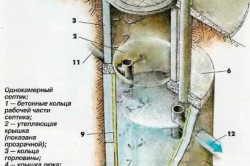
Scheme of waterproofing a single-chamber septic tank.
The whole process is carried out using special high-quality sealants, such as silicone.
Silicone has high level density and is able to close all the holes through which wastewater can escape. Waterproofing septic tanks with this type of hermetic material is the best solution in a situation where protection is needed for many years. It is used in a wide variety of industries, including the construction segment. Other insulating agents are used, but silicones are still the most popular.
How to waterproof a concrete septic tank?
Depending on the level of groundwater, it is necessary to carry out waterproofing work in one way or another. The main thing to consider is that wastewater should not seep into the ground, because they contain a lot of unfavorable microorganisms. They multiply quickly and infest environment. If groundwater is low, then microbes can enter them through cracks, and if it is high, then infection occurs instantly. To make a complete and high-quality sealing of a reinforced concrete septic tank, it is necessary to install a special plastic cylinder.

Scheme of a two-chamber septic tank.
It will need to be cut with a jigsaw at the desired height, and then inserted inside the concrete rings. After that, you can seal the seams with silicone. If the groundwater is high, it is necessary to carry out additional strengthening of the cylinder with the help of special ring stiffeners. The concrete cylinder itself is a sealed device made of 8 mm thick polyethylene. The height of the plastic insert can vary in the factory form from 1 to 4.5 m. You can cut the cylinder, if necessary, to any level.
It is imperative to check the structure for functioning after the winter, since due to the displacement of the soil (at first everything around freezes, and then melts sharply, changing the consistency), insulation problems may arise. The displacement of concrete rings in this case is quite possible, and therefore work to restore the tightness of the sewer system must be carried out immediately. It is necessary that each ring fits snugly against the next one, otherwise troubles cannot be avoided.
Another question to think about before holding is how far from the house the concrete structure will be. It is advisable to dig a hole away from the apartment building, as the smell from the drains can penetrate the room and constantly spoil your mood. The waterproofing of the septic tank prevents the penetration of an unpleasant odor under normal conditions of the functioning of the structure, however, when cleaning the system, even this will not be able to save.
It is quite possible to carry out waterproofing with your own hands. To do this, we recommend that you first familiarize yourself with all the information, prepare materials and tools and get to work.
So, for the construction and waterproofing of concrete rings, you will need the following tools and materials:
- a shovel to dig a well;
- cement (for the bottom of the structure);
- sand (to create a soft pillow);
- crane (for diving);
- several concrete rings;
- silicone as a sealant;
- jigsaw for sawing the cylinder;
- a special plastic cylinder approximately 8 mm thick;
- metal staples for fastening.
What else do you need to know about a septic system?
It is worth saying that in addition to concrete septic tanks, there are many others. But it is this type that is popular due to its advantages, the main of which is ease of installation. The second plus that concrete has is that it is easy to insulate it and you can do it yourself. It is also very important that one septic tank with three wells may well meet the needs of the average family. Additional assistance (for example, cranes) will be required at a very minimum.
Waterproofing septic tanks is also a relatively simple process, but each step must be done scrupulously. It is very important that after the winter, when the concrete absorbs all the moisture (after freezing), the tightness of the structure is not broken. This is the minus of a concrete septic tank - the ability to deform after absorbing moisture. No other shortcomings have been noticed over the long years of using this type of septic tank.
You need to follow carefully, and at the first depressurization it is necessary to carry out additional work for insulation of concrete rings. All work can be carried out independently, as an option - you can entrust the construction and waterproofing of a concrete septic tank to professionals.








